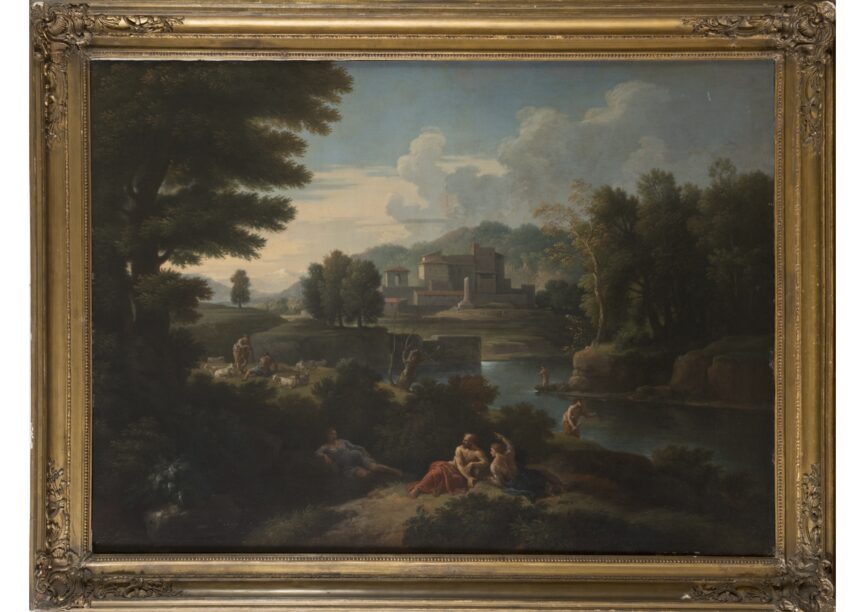JAN FRANS VAN BLOEMEN called ORIZZONTE
Antwerp 1662 - Rome 1749A Classical Landscape with figures reclining beside a river, shepherds tending their flocks beyond and a fortified villa on a promontory beyond
Oil on canvas: 40 1/8 x 53 7/8 in. 102 x 137 cm.
Provenance: Professor Giancarlo Sestieri has kindly indicated on the basis of a high quality photograph that he considers the “paternity” of the present work to be from Jan Frans van Bloemen, known as Orizzonte.
This impressive landscape, with its architectonic structure and muted but glowing palette, probably belongs to the early phase of Van Bloemen’s career soon after his arrival in Rome via Lyon and Turin around 1686-87. In these qualities it exhibits the strong influence of Gaspard Dughet and his brother-in-law Nicolas Poussin, who created the genre of the monumental and classicising landscape, inspired by the campagna around Rome in the 17th.century. The resting figures, the bucolic activities and the harmoniously balanced composition all create a mood of arcadian harmony.
Alain Jacobs, in the Macmillan Dictionary of Art, states that “Considered a great artist by his contemporaries, Orizzonte produced some of the finest classical landscape painting in Rome during the first half of the 18th.century.” His style was a fusion of the Dutch-Italianate painters active in Rome in the mid seventeenth century, and the classical Roman painters, such as Poussin and Dughet, of the same period. Jacobs refers to “a calmer and more synthetic artistic vision” around 1730, “some features of which were borrowed directly from Poussin” so this could be an alternative dating for our painting. Out of these influences he fashioned a technique and a vision which breathes a serenity peculiar to the artist. Every landscape he painted evinced a love for the campagna, its shifting lights and shadows, and the radiance of its early morning and evening skies. His mastery of recession and the bluish horizons which terminate his views gave rise to his pseudonym Orizzonte. As the staffage in the artist’s works was often supplied by Carlo Maratti, Placido Costanzi
or Pompeo Batoni, it is possible that the figures in our landscape could be by one of these painters.
Although extremely popular among Roman patrons, Van Bloemen was only admitted to the Accademia di San Luca at the age of eighty, as a result of a prolonged disagreement with the institution. We know he was in Rome by 1693, the year he married there, and his Dutch roots were reflected in the choice of Caspar van Wittel, also an artistic role model, as godfather to his first child. Van Bloemen’s evocative panoramas were ideal as a means of expressing classical nobility in a picture collection, and they were soon acquired by patrons both north and south of the Alps, who hung them, like their Dughets, as serene resting points between the masterpieces of their collections. He is therefore represented in the Doria-Pamphili Gallery, Rome, at Attingham Park, Shropshire and Schloss Worlitz, near Dessau.
Van Bloemen’s broad but expressive facture sets him apart from his close contemporaries, such as Andrea Locatelli, Paolo Anesi and Gianpaolo Panini. Two of his most effective pupils were Gabriele Ricciardelli and Nicolo Bonito.

